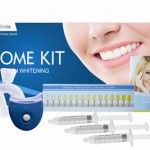I often advise my patients to whiten their teeth at home. When used as directed it can be safe and even more successful than in-office bleaching. The main reason is that you can bleach your teeth at home for longer periods of time, giving the bleaching agent more time to penetrate the teeth and therefore bleach them more effectively. Whitening your teeth at home is also the best way to do ongoing maintenance after your initial teeth whitening.
At home, people have more control over their treatment and can change their treatment regime to suit their specific needs. If you find, for instance, that your teeth becomes a bit sensitive, you can slow down the bleaching process and only use the bleaching product every second or third day. Some people prefer sleeping with the bleaching trays and others prefer bleaching their teeth for a shorter period while awake.
At-Home Teeth Whitening Advantages
- Great results: Whitening teeth slowly over a longer period of time is the best way to get good long-term results. Teeth often get fall-back relatively quickly after in-office bleaching. If you want to keep your teeth white, repeated bleaching, possibly every six months is necessary. The only practical solution is At-Home bleaching.
- Convenience: The patient can choose the whitening products which suit them, and use it when it is most convenient. You don’t need to travel to your dentist’s office or take time from work to get your whiter smile.
- Affordability: The cost to whiten your teeth at home is much less than professional in-office whitening. It is therefore within the reach of most people’s budget. Some over-the-counter whitening products are only a few dollars.
- Use anywhere: If you are traveling a lot, it is possible to take your whitening products along and whiten your teeth where and when it suits you.
Before you start Whitening your Teeth at Home
Visit your dentist to ensure that you do not have any tooth decay, gum disease or any other dental problems requiring treatment. You certainly do not want to apply bleaching agent to a tooth with a deep cavity, it could be a very painful experience!
A professional Scale and Polish (tooth cleaning) is strongly advised before you start your whitening regime. You will get much better results if surface stains, plaque and tatar have been removed first.
I strongly advise supervision by a Dentist, even if you decided on using an over-the-counter bleaching product. Some products can harm your teeth and gum tissue, especially if use incorrectly.
Options for Teeth Whitening at Home
-

Home Bleaching Kit
Bleaching kits and custom made bleaching trays, provided by your Dentist. Please refer to my article ‘Professional Teeth Whitening’ where take-home teeth whitening are discussed in length.
- Bleaching kits with trays or D.I.Y Moldable whitening trays. These can be just as effective as the kits provided by your dentist, but BE CAREFULL! Some of these products have a very strong Hydrogen Peroxide concentration and will harm your teeth and could burn your gums. It is also important to keep in mind that ill fitting trays will allow saliva into the trays which will neutralize the bleaching agent. Crowns and veneers don’t bleach so you may end up with teeth that are much lighter than the crowns.
- Whitening Strips. They are flexible membranes, coated with bleaching gel. Whitening Strips are designed to conform to the shape of the teeth, but it may be difficult if the person has very crooked teeth. The strips may also be a bit short or slip around. The biggest advantage is probably that they are very easy and convenient to use and can be very affective.
- Whitening Pens or Foam-tip Applicators. These are very convenient and easy to use. It can be used directly after meals and may be helpful in maintaining whitened teeth.
- Whitening Toothpastes. All toothpastes help to keep your teeth white as they remove plaque and prevent tatar build-up (which will make your teeth appear yellow). Some toothpastes also includes whitening agents or abrasives such as silica. Be careful not to harm your teeth by causing abrasion of the enamel or dental crowns and veneers.
- Whitening floss. Floss will remove plaque and food from between the teeth and help to prevent staining in these hard to reach areas. Whitening floss use mild abrasives and may assist in removing stains in these areas where other methods fail to reach properly.
For more information regarding the products mentioned above, please see:
These are the most common ways to whiten your teeth at home, but it may be worthwhile to look at my article ‘How to Whiten Teeth’ on treatment for specific stained areas, as well as my articles regarding “Natural Teeth Whitening“.





